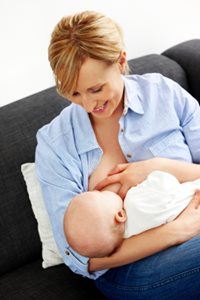What can help with mastitis?

What is mastitis?
Mastitis is when there is redness, tenderness, lumpiness or firmness, pain and/or swelling in the breast, in women who are breast feeding. Women can have one or more of these symptoms, and often it is noticed to be more in one section of the breast. Some women will also feel flu like symptoms, chills, nausea, and a fever, which can sometimes occur overnight or very suddenly with little or no warning.
The development of mastitis may make breast feeding painful and may lead to some mothers stopping breast feeding.
15% of Australian women between 5 and 12 weeks after the birth of their baby experience mastitis, although mastitis can occur at any stage of breast feeding.
Mastitis can occur due to a blockage in the milk ducts, which if not cleared, can then become inflamed (redness and tenderness), which can cause more of a blockage. Sometimes an infection can occur via a cracked nipple, also causing mastitis.
It is important that if you suspect mastitis, and feel any of the above symptoms that you continue breastfeeding. Increasing feeds and resting when possible will assist. If you have access to a breast pump, this may help after breast feeds to resolve lumps. Getting treatment early can help prevent the problem from continuing. You should see your doctor as soon as possible. Getting treatment early can help prevent the problem from continuing.
What can help with mastitis?
Ultrasound Treatment
Doctors sometimes refer women for ultrasound treatment by a Physiotherapist, which can help to unblock the milk ducts when applied over the affected area. If you are unsure whether this may help in your situation, check with your doctor.
Massage
Gentle massage during a feed may help, but make sure that you do not press too hard or this can cause more tenderness and inflammation.
3 different massage suggestions are:
- Massage using your fingers, sweeping gently from under your armpit down towards the nipple.
- Massage lumps gently towards the nipple during and after a feed.
- Massage in a circular motion starting from the nipple to try and clear areas from close to the nipple, then moving out slightly, and continue until you reach underneath your armpit. Gentle massage under a warm shower with a soapy hand can also be helpful.
Cold/Heat
Applying warmth to the affected area before a feed can help let down. Using a warm face cloth may help, or a warm heat pack as long it is not too hot or heavy on the breast, otherwise this may add to the discomfort. The use of a cold compress or ice after a feed can also be useful to help relieve discomfort.
Rest
Rest as much as possible until the mastitis is over. This will help your body to recover more easily.
Keep your breast empty
Keep the affected breast as empty as possible, to keep the milk moving through the breast.
Feed from the affected breast first
Feed from the affected breast first, when baby's sucking is most vigorous.
Have good attachment of your baby onto the breast
If you are unsure regarding your attachment, or are experiencing pain while feeding, not just due to the mastitis, please seek further advice. Your Midwife, Child Health Nurse, Nursing Mothers Counsellor, Lactation Consultant or Doctor should be able to assist. It depends on the services available in your area as to who is the best person to contact for help regarding attachment and positioning of your baby during feeding.
Do not wean at this time
This is not normally a good time to wean your baby.
How can I prevent mastitis?
Good milk flow may prevent mastitis
For good flow, consider the following points:
Good attachment is important
Learning about breast feeding during pregnancy can help prepare you, and make you aware of the key factors for good attachment. Asking for and using the assistance of the midwives while you are in hospital can help you to get established with breast feeding your baby. If you are experiencing any pain during feeding (and you do not have mastitis), your attachment may not be good. Seek advice from the health care provider in your area. Your Midwife, Child Health Nurse, Nursing Mothers Councillor, Lactation Consultant or Doctor should be able to give you advice. It depends on the services available in your area as to who is the best person to contact for help regarding attachment and positioning of your baby during feeding.
There should be no restriction against the breast